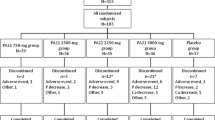Abstract
Background
The adequate control of phosphataemia is of major importance in end-stage renal disease patients on maintenance dialysis. Recently, lanthanum carbonate (LC) has been added to the phosphate binder armamentarium. To our knowledge, no studies have yet evaluated the usefulness of this drug in uncontrolled hyperphosphataemic patients.
Methods
This was a 6-month prospective observational study. Patients on chronic hemodialysis who had previously failed to achieve serum phosphate control were enrolled. Thirty-four patients (i.e. 11% out of 305 from three dialysis units) met the inclusion criteria. Lanthanum carbonate was introduced and titrated to achieve serum phosphate control, according to the KDOQI guidelines. Clinical targets, gastrointestinal symptoms, and patients’ satisfaction with therapy were assessed at baseline and after 6 months.
Results
Eight patients (23.5%) were withdrawn from the study due to side effects. In the remaining patients, serum phosphate level significantly decreased from 5.8 to 4.4 mg/dl and calcium-phosphate product also decreased significantly from 55.6 to 41.8 mg2/dl2. The average number of all phosphate binder tablets taken per day was reduced from 6.7 to 4.7. Evaluation scores of dyspeptic symptoms and of patient’s satisfaction with therapy also improved: from 7.5 to 5.3 and from 6.6 to 8.1, respectively.
Conclusions
The introduction of LC improved serum phosphate control in over 70% of these “difficult patients”. A lower pill burden was also obtained, which might help to simplify treatment and increase patients’ compliance. Dyspeptic symptoms and overall satisfaction with treatment also improved.

Similar content being viewed by others
References
Block GA, Hulbert-Shearon TE, Levin NW et al (1998) Association of serum phosphorus and calcium × phosphorus product with mortality risk in chronic hemodialysis patients: a national study. Am J Kidney Dis 31:607–617
Kanbay M, Goldsmith D, Akcay A et al (2009) Phosphate—the silent stealthy cardiorenal culprit in all stages of chronic kidney disease: a systematic review. Blood Purif 27(2):220–230
National Kidney Foundation (2003) K/DOQI clinical practice guidelines for bone metabolism and disease in chronic kidney disease. Am J Kidney Dis 42:S1–S201
Young EW, Albert JM, Satayathum S et al (2005) Predictors and consequences of altered mineral metabolism: the Dialysis Outcomes and Practice Patterns Study. Kidney Int 67:1179–1187
Hutchison AJ, Barnett ME, Krause R et al (2008) SPD405-309 Lanthanum Study Group. Long-term efficacy and safety profile of lanthanum carbonate: results for up to 6 years of treatment. Nephron Clin Pract 110:c15–c23
Cannata-Andía JB, Fernández-Martín JL, Zoccali C et al (2008) Current management of secondary hyperparathyroidism: a multicenter observational study (COSMOS). J Nephrol 21(3):290–298
el-Omar EM, Banerjee S, Wirz A et al (1996) The Glasgow Dyspepsia Severity Score—a tool for the global measurement of dyspepsia. Eur J Gastroenterol Hepatol 8:967–971
Monés J, Adan A, López JS et al (2001) Validation of the Spanish version of the Glasgow Dyspepsia Severity Score. Rev Esp Enferm Dig 93:164–175
Lorenzo V, Martin-Malo A, Perez-Garcia R et al (2006) Prevalence, clinical correlates and therapy cost of mineral abnormalities among haemodialysis patients: a cross-sectional multicentre study. Nephrol Dial Transplant 21:459–465
Mehrotra R, Martin KJ, Fishbane S et al (2008) Higher strength lanthanum carbonate provides serum phosphorus control with a low tablet burden and is preferred by patients and physicians: a multicenter study. Clin J Am Soc Nephrol 3:1437–1445
Finn WF, Joy MS, Hladik G, Lanthanum Study Group (2004) Efficacy and safety of lanthanum carbonate for reduction of serum phosphorus in patients with chronic renal failure receiving hemodialysis. Clin Nephrol 62:193–201
Hutchison AJ, Laville M, SPD405-313 Lanthanum Study Group (2008) Switching to lanthanum carbonate monotherapy provides effective phosphate control with a low tablet burden. Nephrol Dial Transplant 23:3677–3684
Chan WL, Rounsley K, Chapman E et al (2010) Lanthanum carbonate is an effective hypophosphatemic agent for hemodialysis patients intolerant of other phosphate binders. J Ren Nutr 20(4):270–277
Benson K, Hartz AJ (2000) A comparison of observational studies and randomized, controlled trials. N Engl J Med 342:1878–1886
Grootendorst DC, Jager KJ, Zoccali C et al (2010) Observational studies are complementary to randomized controlled trials. Nephron Clin Pract. 114(3):c173–c177
Goldsmith DJ, Covic A (2008) Calcium and the saga of the binders: accumulating controversy, or building consensus? Int Urol Nephrol 40(4):1009–1014
St Peter WL, Fan Q, Weinhandl E et al (2009) Economic evaluation of sevelamer versus calcium-based phosphate binders in hemodialysis patients: a secondary analysis using centers for Medicare & Medicaid services data. Clin J Am Soc Nephrol 4:1954–1961
Navaneethan SD, Palmer SC, Craig JC et al (2009) Benefits and harms of phosphate binders in CKD: a systematic review of randomized controlled trials. Am J Kidney Dis 54:619–637
Acknowledgments
We acknowledge the support of Sylva Astrik Torossian for the grammatical revision of the manuscript.
Conflict of interest
None declared.
Author information
Authors and Affiliations
Corresponding author
Rights and permissions
About this article
Cite this article
Almirall, J., Betancourt, L., Esteve, V. et al. Clinical usefulness of lanthanum carbonate for serum phosphate control in difficult patients. Int Urol Nephrol 44, 231–236 (2012). https://doi.org/10.1007/s11255-010-9860-2
Received:
Accepted:
Published:
Issue Date:
DOI: https://doi.org/10.1007/s11255-010-9860-2




